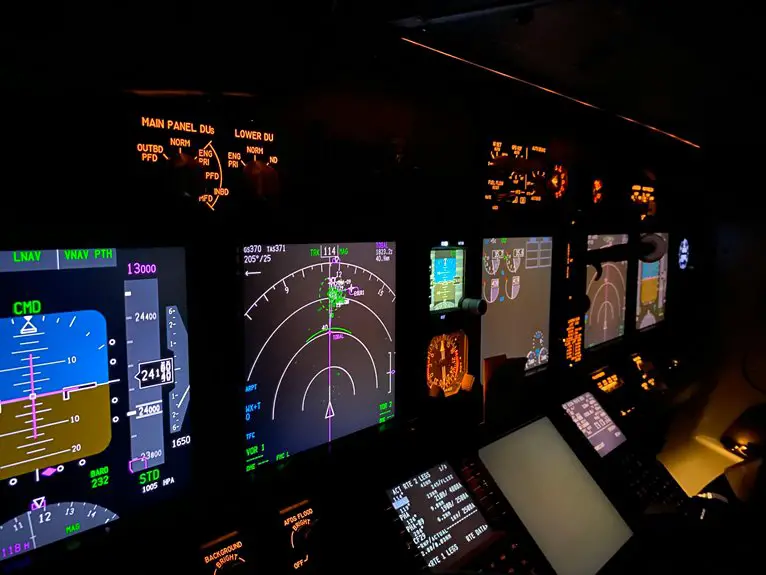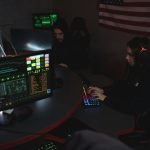If you're working with multiple monitors, setting up shortcuts can significantly boost your efficiency. You'll want to familiarize yourself with essential keyboard combinations and explore how to customize your navigation. This not only streamlines your workflow but also makes managing applications across screens much simpler. Ready to discover the best strategies for optimizing your multi-monitor setup? Let's explore how you can transform your navigation experience.
Table of Contents
Key Takeaways
- Use Windows + P to quickly switch between display modes for multi-monitor setups, such as extending or duplicating displays.
- Utilize Windows + Shift + Left/Right Arrow to seamlessly move applications between monitors with a simple keyboard shortcut.
- Employ Alt + Tab to cycle through open applications, allowing for efficient task switching across multiple screens.
- Set up Windows + D to minimize or restore all windows, providing a clear view of the desktop and open applications.
- Consider third-party tools like DisplayFusion or UltraMon for customizable shortcuts and enhanced multi-monitor management features.
Understanding Multi-Monitor Setup
When you set up a multi-monitor configuration, you create an expanded workspace that can boost your productivity significantly. You can easily switch between tasks, reducing the time spent minimizing and maximizing windows.
Position your monitors to suit your workflow—whether that means side-by-side or one above the other. This arrangement allows you to keep essential applications open while working on another screen, enhancing your focus.
Additionally, using different monitors for specific tasks can help you stay organized. For instance, you might dedicate one screen to emails and another to a project management tool.
Configuring Display Settings
To make the most of your multi-monitor setup, you need to configure your display settings effectively.
Start by adjusting the monitor arrangement and resolution settings to suit your workspace.
Additionally, ensure each display is correctly identified to avoid confusion during navigation.
Adjusting Monitor Arrangement
Adjusting your monitor arrangement is crucial for effective multi-monitor navigation, especially as you expand your workspace.
Start by accessing your display settings through your operating system. You'll see a visual representation of your monitors, which allows you to drag and drop them into the correct positions. Make sure the primary display—the one with your taskbar or dock—aligns with your most frequently used monitor.
If your monitors are different sizes, position them accordingly to minimize head movement. Save your settings, and test the arrangement by moving your mouse across screens. This ensures you're navigating smoothly and intuitively.
A well-organized setup enhances productivity and reduces strain, making your multi-monitor experience more enjoyable and efficient.
Resolution Settings Adjustment
Configuring your resolution settings is essential for achieving optimal clarity and performance across multiple monitors. Start by right-clicking on your desktop and selecting "Display settings." Here, you can adjust each monitor's resolution individually. Aim for a resolution that matches your monitor's native setting for the best results.
| Monitor | Recommended Resolution |
|---|---|
| Primary Monitor | 1920 x 1080 |
| Secondary Monitor | 2560 x 1440 |
| Tertiary Monitor | 3840 x 2160 |
Once you've set the correct resolutions, apply the changes and confirm the settings. This ensures a seamless workflow and better visuals while navigating between displays. Don't forget to test each monitor for clarity and responsiveness!
Multiple Display Identification
Identifying your multiple displays is crucial for efficient navigation and workflow.
Start by right-clicking on your desktop and selecting "Display settings." Here, you'll see all connected monitors listed. Each display will have a number assigned to it, which helps you know which is which. Click "Identify," and large numbers will briefly appear on each screen, making it easy to match them with the settings.
You can also adjust the orientation and scaling for each display here. Remember to set your primary display—this is where your main applications will launch.
Once you've configured everything, apply your settings. With these steps, you'll streamline your multi-monitor experience and enhance your productivity significantly.
Using Keyboard Shortcuts
Mastering keyboard shortcuts can significantly enhance your efficiency when navigating multiple monitors. By integrating these shortcuts into your workflow, you'll save time and streamline your tasks.
Here are some essential keyboard shortcuts to get you started:
- Windows + P: Quickly switch between display modes.
- Windows + Shift + Left/Right Arrow: Move active windows between monitors.
- Alt + Tab: Cycle through open applications seamlessly.
- Windows + D: Minimize or restore all windows for a clear desktop view.
- Windows + Number: Launch applications pinned to your taskbar.
Utilizing these shortcuts helps you manage multiple monitors more effectively, allowing you to focus on your work without constant interruptions.
Customizing Mouse Navigation
When you're navigating multiple monitors, customizing your mouse settings can enhance your efficiency.
You can create mouse shortcuts, adjust pointer movement, and manage your application windows to streamline your workflow.
Let's explore how these tweaks can make your multi-monitor experience smoother.
Mouse Shortcuts Overview
Customizing mouse shortcuts can significantly enhance your multi-monitor navigation experience.
By setting up specific shortcuts, you can streamline your workflow and reduce the time spent moving between screens.
Here are some key mouse shortcuts to consider:
- Switch Displays: Quickly toggle between monitors with a simple click.
- Snap Windows: Use mouse shortcuts to snap applications to the edges of your screens.
- Move Windows: Drag windows across monitors effortlessly.
- Open Task View: Access all open windows with a designated mouse action.
- Zoom In/Out: Adjust your view easily with a customizable mouse shortcut.
Configuring Pointer Movement
Effective multi-monitor navigation not only involves shortcuts but also optimizing how your pointer moves across screens. To enhance your experience, you can adjust settings for sensitivity and acceleration in your operating system. This way, you'll find it easier to glide from one monitor to another without frustration.
Here's a quick reference table to help you visualize the adjustments:
| Setting | Recommendation |
|---|---|
| Pointer Speed | Medium to High |
| Acceleration | Moderate |
| Primary Monitor | Center Screen |
| Edge Movement | Enable (if needed) |
Experiment with these settings until you find what feels right. An optimized pointer movement can significantly streamline your workflow across multiple displays.
Managing Application Windows
Navigating multiple application windows efficiently can transform your productivity across several screens.
To manage your application windows better, consider these tips for customizing mouse navigation:
- Use Snap Assist: Quickly align windows side by side by dragging them to the edges of your screens.
- Keyboard Shortcuts: Learn shortcuts for switching between windows, like Alt + Tab or Windows + D.
- Virtual Desktops: Organize different tasks by creating separate virtual desktops for focused work.
- Taskbar Management: Pin frequently used applications to your taskbar for one-click access.
- Third-Party Tools: Explore software like DisplayFusion or AquaSnap for enhanced window management features.
Implementing these strategies will streamline your workflow and make managing multiple screens effortless.
Third-Party Tools for Enhanced Productivity
Many users find that third-party tools can significantly boost productivity in a multi-monitor setup. Tools like DisplayFusion and UltraMon offer features that simplify window management, allowing you to customize your workspace.
With these applications, you can create shortcuts for moving windows between monitors or automatically arrange them based on your preferences.
You can also use tools like PowerToys, which includes a FancyZones feature to create custom layouts for your applications.
These enhancements streamline your workflow, making it easier to focus on tasks without getting bogged down by window organization.
Troubleshooting Common Multi-Monitor Issues
Even with the help of third-party tools, you might still encounter issues in your multi-monitor setup.
Here are some common problems and quick fixes to keep in mind:
- Display not detected: Check your connections and ensure all cables are securely plugged in.
- Resolution mismatch: Adjust the display settings in your operating system to match each monitor's native resolution.
- Cursor lag: Update your graphics drivers or lower the display resolution to improve performance.
- Windows not maximizing: Drag the application to the desired monitor and use shortcuts to maximize it.
- Taskbar issues: Right-click the taskbar, go to settings, and configure it to show on all monitors or just one.
With these tips, you should be able to resolve most common multi-monitor issues efficiently.
Frequently Asked Questions
Can I Use Different Monitor Resolutions in a Multi-Monitor Setup?
Yes, you can use different monitor resolutions in a multi-monitor setup. Just ensure your graphics card supports it. Adjust the display settings in your operating system to optimize each monitor according to its native resolution.
How Do I Reset My Multi-Monitor Configuration?
To reset your multi-monitor configuration, go to your display settings. Select each monitor and choose "Reset" or "Detect." Adjust the resolution and orientation as needed, then save your changes for a fresh setup.
Are There Specific Shortcuts for Gaming Across Multiple Monitors?
Yes, there are specific shortcuts for gaming across multiple monitors. You can quickly switch between screens using Alt + Tab or Windows + P. Customize your settings in-game for optimal performance and seamless navigation across displays.
Will Using Multiple Monitors Affect My Computer's Performance?
Using multiple monitors can impact your computer's performance, especially if your hardware isn't powerful enough. You'll notice slower speeds or reduced frame rates during demanding tasks, so ensure your system meets the requirements for optimal performance.
Can I Set Different Wallpapers for Each Monitor?
Yes, you can set different wallpapers for each monitor. Right-click on your desktop, select "Personalize," then choose "Background." From there, select each monitor and customize its wallpaper to your liking. Enjoy your personalized setup!




